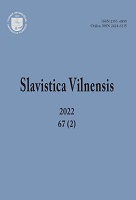Oikonimų slavinimo ypatybės periferinėje lietuvių tarmėje
Features of Slavization of Oikonіms in the Peripheral Lithuanian Dialect
Author(s): Nijolė TuomienėSubject(s): Phonetics / Phonology, Sociolinguistics, Baltic Languages
Published by: Vilniaus Universiteto Leidykla
Keywords: the peripheral dialect of the Lithuanian language; bilingualism; the interaction of languages; features of slavization of oikonyms; sociolinguistics;
Summary/Abstract: The article aims to analyze the peculiarities of the Slavization of place names – oikonyms – of the Voronovo district (Belarus) based on names of places of residence collected from the living language of the inhabitants. The aim of the study is to determine what possible ways of Slavization of oikonyms are characteristic of this continuation of the Southern Aukštaitian dialect outside the Republic of Lithuania. The study takes into account the sociolinguistic situation of the region, which influenced the formation of toponyms of the research area. Since the 20th century, the ethnic and linguistic situation in the vicinity of the Voronovo district changed dramatically. From the bilingualism of Lithuanian and Belarusian, there was a transition to exclusively Slavic languages: Belarusian, Polish, and Russian. The characteristics of the Slavization of the oikonym were influenced by the different rates of Slavization in the surrounding areas. Oikonyms are translated into another language in two ways – by translation and word-of-mouth. The recorded examples of translation show that when translating Lithuanian oikonyms into the local Belarusian poprostu dialect, the same gender and number are kept. Interpretive rendition is considered the main method of Slavization of oikonyms, which can be based only on morphological equivalents: prefixes, suffixes, and endings. A prefixed way of rendering oikonyms is not productive. Suffixing is the most complex form of morphological adaptation. The following rule is consistently followed: the vowels of the Lithuanian suffix acquire a phonetically well-chosen counterpart in the Belarusian suffix, but other elements of the suffix are already combined according to morphological, not phonetic, criteria. The limb rendering group is the largest. This method is the closest to phonetic rendering.
Journal: Slavistica Vilnensis
- Issue Year: 67/2022
- Issue No: 2
- Page Range: 52-68
- Page Count: 17
- Language: Lithuanian

